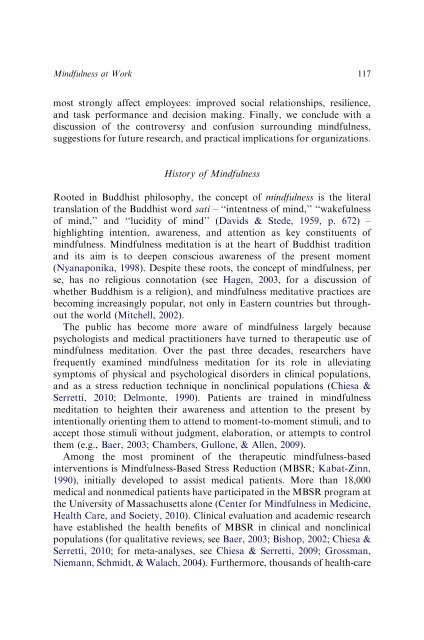Mindfulness at work (Glomb, Duffy et al, 2012) - Human Resources
Mindfulness at work (Glomb, Duffy et al, 2012) - Human Resources
Mindfulness at work (Glomb, Duffy et al, 2012) - Human Resources
You also want an ePaper? Increase the reach of your titles
YUMPU automatically turns print PDFs into web optimized ePapers that Google loves.
<strong>Mindfulness</strong> <strong>at</strong> Work 117most strongly affect employees: improved soci<strong>al</strong> rel<strong>at</strong>ionships, resilience,and task performance and decision making. Fin<strong>al</strong>ly, we conclude with adiscussion of the controversy and confusion surrounding mindfulness,suggestions for future research, and practic<strong>al</strong> implic<strong>at</strong>ions for organiz<strong>at</strong>ions.History of <strong>Mindfulness</strong>Rooted in Buddhist philosophy, the concept of mindfulness is the liter<strong>al</strong>transl<strong>at</strong>ion of the Buddhist word s<strong>at</strong>i – ‘‘intentness of mind,’’ ‘‘wakefulnessof mind,’’ and ‘‘lucidity of mind’’ (Davids & Stede, 1959, p. 672) –highlighting intention, awareness, and <strong>at</strong>tention as key constituents ofmindfulness. <strong>Mindfulness</strong> medit<strong>at</strong>ion is <strong>at</strong> the heart of Buddhist traditionand its aim is to deepen conscious awareness of the present moment(Nyanaponika, 1998). Despite these roots, the concept of mindfulness, perse, has no religious connot<strong>at</strong>ion (see Hagen, 2003, for a discussion ofwh<strong>et</strong>her Buddhism is a religion), and mindfulness medit<strong>at</strong>ive practices arebecoming increasingly popular, not only in Eastern countries but throughoutthe world (Mitchell, 2002).The public has become more aware of mindfulness largely becausepsychologists and medic<strong>al</strong> practitioners have turned to therapeutic use ofmindfulness medit<strong>at</strong>ion. Over the past three decades, researchers havefrequently examined mindfulness medit<strong>at</strong>ion for its role in <strong>al</strong>levi<strong>at</strong>ingsymptoms of physic<strong>al</strong> and psychologic<strong>al</strong> disorders in clinic<strong>al</strong> popul<strong>at</strong>ions,and as a stress reduction technique in nonclinic<strong>al</strong> popul<strong>at</strong>ions (Chiesa &Serr<strong>et</strong>ti, 2010; Delmonte, 1990). P<strong>at</strong>ients are trained in mindfulnessmedit<strong>at</strong>ion to heighten their awareness and <strong>at</strong>tention to the present byintention<strong>al</strong>ly orienting them to <strong>at</strong>tend to moment-to-moment stimuli, and toaccept those stimuli without judgment, elabor<strong>at</strong>ion, or <strong>at</strong>tempts to controlthem (e.g., Baer, 2003; Chambers, Gullone, & Allen, 2009).Among the most prominent of the therapeutic mindfulness-basedinterventions is <strong>Mindfulness</strong>-Based Stress Reduction (MBSR; Kab<strong>at</strong>-Zinn,1990), initi<strong>al</strong>ly developed to assist medic<strong>al</strong> p<strong>at</strong>ients. More than 18,000medic<strong>al</strong> and nonmedic<strong>al</strong> p<strong>at</strong>ients have particip<strong>at</strong>ed in the MBSR program <strong>at</strong>the University of Massachus<strong>et</strong>ts <strong>al</strong>one (Center for <strong>Mindfulness</strong> in Medicine,He<strong>al</strong>th Care, and Soci<strong>et</strong>y, 2010). Clinic<strong>al</strong> ev<strong>al</strong>u<strong>at</strong>ion and academic researchhave established the he<strong>al</strong>th benefits of MBSR in clinic<strong>al</strong> and nonclinic<strong>al</strong>popul<strong>at</strong>ions (for qu<strong>al</strong>it<strong>at</strong>ive reviews, see Baer, 2003; Bishop, 2002; Chiesa &Serr<strong>et</strong>ti, 2010; for m<strong>et</strong>a-an<strong>al</strong>yses, see Chiesa & Serr<strong>et</strong>ti, 2009; Grossman,Niemann, Schmidt, & W<strong>al</strong>ach, 2004). Furthermore, thousands of he<strong>al</strong>th-care


